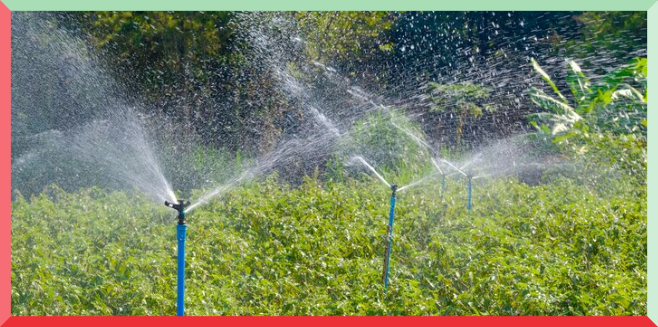
Sprinklers are a popular and effective choice for irrigation.
However, a major downside is that many sprinklers are unstable and cannot withstand external factors such as high water pressure, loose soil, or improper installation.
This instability is usually not an issue for small sprinkler heads that rest directly on the ground and cover a limited area. Additionally, tripod sprinklers come with built-in stands, providing extra stability.
The real challenge arises when installing a PVC-mounted sprinkler at a certain height to cover a large area. Without proper stabilization, these sprinklers can become wobbly, causing water to spray unevenly or in unintended directions. This can lead to dry spots and water wastage.
In this blog post, I’ll share practical tips to stabilize sprinkler jets for consistent and efficient water distribution.
Use Wood

If you place the sprinkler head above 2-3 feet from the ground, you should use support for the pipe to handle the pressure.
An easy fix is to use a wooden stick to support the sprinkler, place it near the sprinkler, and tie it with a rope so that the sprinkler cannot shake.
Recently, I installed a sprinkler on my farm, and I used this technique, and it worked well.
The downside of using wood is that it will decay after a few years, so you have to replace it often.
Use Rock
Using a rock for stabilizing the sprinkler head is a good method. You don’t have to replace the rock, and it provides solid support for the sprinkler.
However, installing the rock beside the sprinkler head is a hefty task, and the rock pillars are expensive. Additionally, they may not come in the size you need.
Use Sprinkler Risers
Apart from the wood and rock, you can shop for sprinkler raisers to support sprinklers from wind gusts that can divert spray.
Installing sprinkler risers raises each sprinkler 6-12 inches off the ground. This elevates the jets above grass and plants, preventing them from obstructing water flow.
When shopping for risers, choose strong metal models made of copper, steel, or thick plastic capable of supporting the sprinkler head without leaning or tipping. Install a riser on each sprinkler placed in windy areas around the lawn.
Replace Nozzles
Over time, sprinkler nozzles become worn for various reasons, such as erosion, resulting in an unstable sprinkler causing uneven water distribution
To address this issue, replacing old nozzles is an easy fix.
High Water Pressure
Installing the sprinkler without knowing the water pressure can cause turbulence, destabilizing them. Sometimes, even installing too many sprinklers can be a significant cause of destabilization.
Installing a pressure regulator can help lower the pressure.
Adjust Sprinkler Body
Misaligned sprinkler bodies can cause dramatic wiggly water motions, wasting water.
To tackle the issue, you can simply use a level to ensure the body is vertically straight because tilted heads with leaning bodies prevent balanced flow.
To be specific, for traditional rotating sprinklers, center the body over the swinging arm so the nozzle opening aligns directly above as the arm makes a full rotation. Use shims under the sprinkler base if needed to gain the right height.
For stationary spray head sprinklers, position the body with the nozzle facing straight up and the body back facing the incoming water source pipe for the most direct water path. This placement minimizes turbulence inside the body to create even water flow.
Soil debris and many tiny obstructions can lodge inside the sprinkler nozzles, obstructing the internal water flow resulting in sprinkler uneven spraying off in a random direction, destabilizing the sprinkler.
To clear out the nozzles use the thin wire or a nozzle cleaning tool to gently clean out the nozzle opening. Even better is installing mesh “strainer baskets” inside sprinkler heads for preventing future clogs, you just need to routinely check and clean out the strainer basket.
Adjust Nozzles
Checking the sprinkler nozzle alignment is the key to eliminating the wobbly sprinkler.
If the nozzle is tilted to one side or rotated incorrectly, it can send the water streaming out at an angle. Straighten the nozzle so it faces directly upright. You can use a small level to ensure the nozzle is oriented precisely vertically.
Moreover, inspect the nozzle opening because, over time, nozzle holes can get bigger from erosion. An enlarged hole can cause uneven water flow. Replace old nozzles to restore uniform water pressure through the opening. Make sure any new nozzles are the correct model for your sprinkler heads.
Final Thought…
Unstable sprinkler jets result in uneven water distribution. Fixing the sprinkler wiggle and wave maximizes the irrigation system efficiency.
To tackle the problem, possible solutions are given above, like checking for clogs, worn parts, and proper positioning when faced with irregular sprinkle patterns. Adjust pressure levels as needed as well.
With these simple tweaks, you can have your sprinkler jets distributing water evenly for luscious green grass and healthy gardens.

Leave a Reply